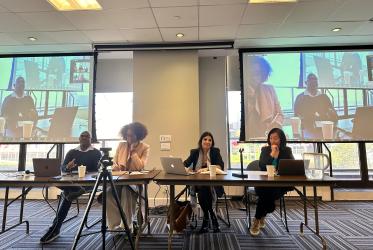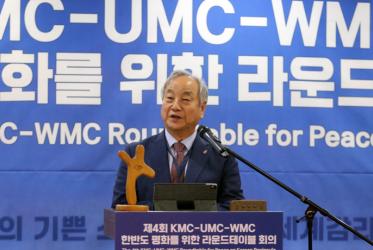“O mortal, can these bones live?” – Du weisst es. – “You know, O Lord.”
It is a simple confession of faith. Not nearly so grandiose as some might offer. Not a loud, ringing endorsement – “Yes! These bones shall live!”
No: this is a modest statement of faith, dependent on a mysterious God: You alone, Lord, can be sure whether these bones will live – and I am satisfied that you know.
“Wer bin ich?” wrote Dietrich Bonhoeffer in his cell. “Who am I?”
And in the end, he concluded, Wer ich auch bin, Du kennst mich, Dein bin ich, o Gott. “You know me, God: I am yours.”
Who was he? Well, there is some honest disagreement…
For example… Dietrich Bonhoeffer is not commemorated at Yad va Shem in Israel - he is not recognized by the competent authorities as one of the Righteous Gentiles who can be proven to have saved lives of European Jews during the Holocaust.
Appeals to this ruling are made from time to time, and new evidence introduced in his favour, but so far these protests have failed to convince the directors of Yad va Shem.
And the hard fact is that, early in the war, Bonhoeffer chose – in his own words – to “join the great masquerade of evil” in Berlin, accepting an appointment to service in the Abwehr, military intelligence, in the hope of being more effective in the conspiracy to bring down the Nazi regime and, eventually, to assassinate Adolf Hitler.
Some are more inclined to marvel at an earlier choice made by the young theologian. When the war broke out in Europe, he was a visiting professor at Union Theological Seminary in New York City – in what was then still a neutral nation, the United States of America.
Dietrich Bonhoeffer was invited to remain in the United States, teaching at Union Seminary, for the duration of the conflict, however long that might be.
He replied that he must return to Germany, for only those who suffered through the coming years of tragedy would be qualified to assist in the rebuilding of that country after the war.
So he returned, and he participated in the great masquerade, and in treason and in suffering.
Years earlier, in the mid-1930s, Bonhoeffer had told his students in the midst of a seminar on worship, “Only someone who speaks out for the Jews has the right to sing Gregorian chants.”
He had a history of speaking for the Jews and against Hitler, in public, at great personal risk.
And at the clandestine Confessing Church pastoral formation centre at Finkenwalde, he told his seminarians just what he thought.
But that period is remembered in various ways, and at one time especially for his book Communio Sanctorum, or Life Together, so that Finkenwalde came to be seen by many more as an exercise in spiritual community than in radical resistance.
Bonhoeffer is one of the most frequently quoted of 20th-century Christian theologians, and sometimes it is for the sake of his near-mystical vision of the church and its koinonia, sometimes, for the quasi-monastic fellowship of that underground seminary, sometimes, it is for his love of this world and its beauty, for music and art, sport and family, sometimes, for the celebration of his remarkable network of friendships throughout the world, and sometimes he is remembered for his poetry, biblical and secular, but most often, these days, he is cited for those hints and suggestions in the fragmentary writings of his final years, in letters and meditations and rough notes and prayers and poems which spoke of Jesus as, above all else, “the man for others,” and of our own discipleship as a calling to embody “a church for others;” for his recognition that “in a world of suffering, only a suffering God can help;” and finally, he wrote of the urgent need for a “religionless Christianity” to serve and bring reconciliation to “a world come of age”–a world that no longer needs the hypothesis of God, although Bonhoeffer himself never ceased to speak that name.
The remarkable thing is that all of these different ideas and assertions are authentic aspects of Bonhoeffer’s life and thought.
His life... not just his thought – that’s another remarkable thing: As Barbara Green once said, “What he thought, he believed. And what he believed, he did.”
Not that what he did was always understood or appreciated. His father, a distinguished professor of psychiatry at the University of Berlin, was bitterly disappointed when he learned his son was planning to enter the church.
Why should such an intellect be wasted on something so peripheral to real life? Later, Dietrich himself was frequently disappointed by the church – and I’m talking about the Confessing Church and the councils of the ecumenical movement.
Often, he found their workings political in the worst sense of the word, too quick to compromise, and too concerned for appearances; too little concerned for action on behalf of others, or for justice.
His sacramental vision of the church may have been idealistic, but he was always keenly aware of the hard realities.
Some ecumenical leaders found him lacking in gratitude. They were trying so hard to support the Confessing Church in Germany: How dare brother Dietrich demand that they do even more?
Many came to be deeply suspicious of his basic allegiance, as when, in 1940, he accepted his posting to the German army’s intelligence service.
We know now that he joined the Abwehr to participate in the conspiracy. But what were people to think at the time, when they heard Bonhoeffer had gone to work for the German Army at the height of Nazi aggression?
Only his closest friends and colleagues abroad continued to trust him – including Bishop George Bell of Chichester, who in 1948 would become the first moderator of the World Council of Churches.
Dietrich Bonhoeffer had given up his career in theology, risked his reputation, and separated himself from old friends and colleagues, in the hope of making a concrete difference in the life of the world.
On July 21, 1944, the day after the failure of Operation Walküre, the assassination plot, Bonhoeffer intimated in a prison letter to his alter-ego, Eberhard Bethge, that despite the failure of the conspiracy and the near-inevitability, now, of his death, he was relieved that at last he would be seen again as on the side of good, and not of evil. (“The cost of discipleship,” indeed!)
Looking at his life, we can see that Dietrich Bonhoeffer was a theologian of the practical, of the Penultimate, of taking the Ultimate seriously enough to work for the transformation of this world, and to endeavour to imitate Christ in unimagined and unlikely ways.
An American friend of Bonhoeffer’s, the Christian social ethicist Paul Lehmann, famously advised his own students: “Proclaim the gospel, and let the chips fall where they may!”
This may not always be the best advice, if you want to have your name inscribed on a wall at Yad va Shem. But a thing does not need to be written in stone to be valid. There are different ways to express righteousness.
Perhaps we must be content with this modest confession of faith: Wer bin ich? Einsames Fragen treibt mit mir Spott. Wer ich auch bin, Du kennst mich, Dein bin ich, o Gott. ["Who am I? It is the singular question that mocks me. "Whatever else I am - you know me. I am yours, O God."]
Or, to put it another way: “O mortal, can these bones live?” – “You know, O Lord. You know.” Amen.







